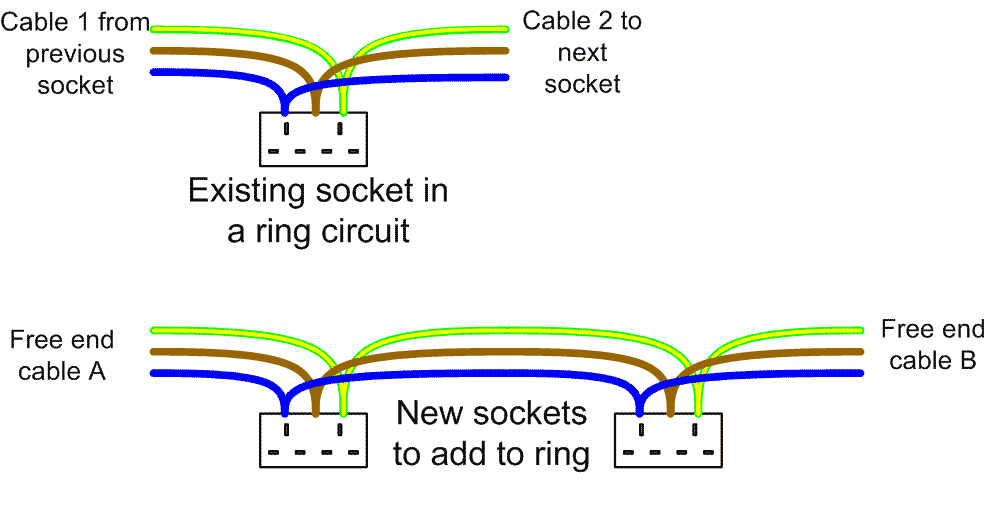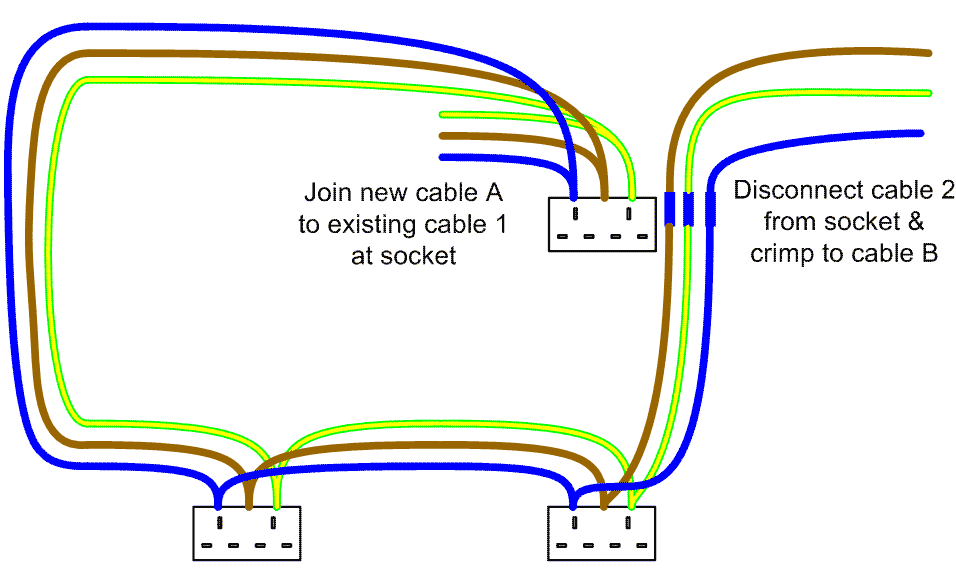Difference between revisions of "Easy socket extensions"
(First draft.) |
m (→Method: Change scaling on pictures so they don't look so rough.) |
||
| (8 intermediate revisions by 3 users not shown) | |||
| Line 1: | Line 1: | ||
| − | |||
==Introduction== | ==Introduction== | ||
| − | + | Note for a general article covering the broader topic of adding sockets to existing circuits, see the [[Adding sockets]] article. This article addresses one specific case of circuit expansion. | |
| − | This article describes a simple way to add extra sockets to a ring circuit such that they are fully integrated into the ring, but you are only required to make alterations at a single existing socket or accessory location. | + | When more sockets are required on an existing ring [[House Wiring for Beginners#Ring|circuit]] (for radial circuits, see the general article mentioned above), it is often easiest to simply add an additional single or double socket as an "unfused spur". However this is not appropriate when you need to add lots of extra sockets, or when you are expecting appliances that will draw a very high load from the new socket (say a washing machine and tumble drier in a utility room). In these cases it is far better the new sockets so they become a fully integrated part of the ring. However, implementing by the classical approach can be tricky; (i.e. by grafting the new sockets between a pair of existing sockets, running new cables to both and disconnecting (or reusing) the existing link cable). This article describes a simple way to add extra sockets to a ring circuit such that they are still fully integrated into the ring, but you are only required to make alterations at a single existing socket or accessory location. |
==Method== | ==Method== | ||
| Line 11: | Line 10: | ||
Imagine you are adding a pair of new sockets as shown in the picture below: | Imagine you are adding a pair of new sockets as shown in the picture below: | ||
| − | [[Image:AddingSockets1.gif | + | [[Image:AddingSockets1.gif|Click for larger picture]] |
| − | Daisy chain all your new sockets together, and take '''both''' of the free cable ends to an existing socket location. Try and pick a socket that only has two | + | Daisy chain all your new sockets together, and take '''both''' of the free cable ends to an existing socket location. Try and pick a socket that only has two [[cable]]s connected (i.e. just the ring connections and no existing spur), and which has a reasonably deep [[Pattress|back box]] - 35mm is much easier to work in than 25mm!) |
| − | Now disconnect one of the existing | + | Now disconnect one of the existing [[cable]]s from the existing socket, and replace it with one of the new "ends" from your additional sockets. Next using insulated [[Cable_crimping|crimp connectors]], join the old disconnected cable wires to the other [[cable]] from the new sockets: |
| − | [[Image:AddingSockets2.gif | + | [[Image:AddingSockets2.gif|Click for larger picture]] |
| − | Finish the installation by carefully arranging the new cables in the back box such that they do not prevent the socket fitting back correctly (this is why crimps are greatly preferable to chock block style screw terminals - they take up much less space). If you need to open a new cable entry hole in a back box, remember to protect the cables using [[Electrical Installation#Mechanical protection|grommets]] where appropriate. | + | Finish the installation by carefully arranging the new cables in the [[Pattress|back box]] such that they do not prevent the socket fitting back correctly (this is why crimps are greatly preferable to chock block style screw terminals - they take up much less space). If you need to open a new cable entry hole in a back box, remember to protect the cables using [[Electrical Installation#Mechanical protection|grommets]] where appropriate. |
==Testing== | ==Testing== | ||
| − | The most effective test is carried out at the consumer unit. '''Prior''' to altering the wiring, test the round trip resistance between the ends of the circuit at the CU (this will save looking for an existing fault in the wrong place!) Make a note of the round trip resistance for Live, Neutral and Earth (you would expect the earth round trip to be slightly higher than the Live or Neutral readings). Repeat the test after the new sockets are grafted in, and check that the resistance increase is only slight, and inline with that [[Electrical_Circuit_Faults#Wire_resistance_table|expected]] based on the amount of new cable introduced. | + | The most effective test is carried out at the [[Consumer Units|consumer unit]]. '''Prior''' to altering the wiring, test the round trip resistance between the ends of the circuit at the CU (this will save looking for an existing fault in the wrong place!) Make a note of the round trip resistance for Live, Neutral and Earth (you would expect the earth round trip to be slightly higher than the Live or Neutral readings). Repeat the test after the new sockets are grafted in, and check that the resistance increase is only slight, and inline with that [[Electrical_Circuit_Faults#Wire_resistance_table|expected]] based on the amount of [[Cable|new cable]] introduced. |
Latest revision as of 16:52, 9 January 2022
Introduction
Note for a general article covering the broader topic of adding sockets to existing circuits, see the Adding sockets article. This article addresses one specific case of circuit expansion.
When more sockets are required on an existing ring circuit (for radial circuits, see the general article mentioned above), it is often easiest to simply add an additional single or double socket as an "unfused spur". However this is not appropriate when you need to add lots of extra sockets, or when you are expecting appliances that will draw a very high load from the new socket (say a washing machine and tumble drier in a utility room). In these cases it is far better the new sockets so they become a fully integrated part of the ring. However, implementing by the classical approach can be tricky; (i.e. by grafting the new sockets between a pair of existing sockets, running new cables to both and disconnecting (or reusing) the existing link cable). This article describes a simple way to add extra sockets to a ring circuit such that they are still fully integrated into the ring, but you are only required to make alterations at a single existing socket or accessory location.
Method
Imagine you are adding a pair of new sockets as shown in the picture below:
Daisy chain all your new sockets together, and take both of the free cable ends to an existing socket location. Try and pick a socket that only has two cables connected (i.e. just the ring connections and no existing spur), and which has a reasonably deep back box - 35mm is much easier to work in than 25mm!)
Now disconnect one of the existing cables from the existing socket, and replace it with one of the new "ends" from your additional sockets. Next using insulated crimp connectors, join the old disconnected cable wires to the other cable from the new sockets:
Finish the installation by carefully arranging the new cables in the back box such that they do not prevent the socket fitting back correctly (this is why crimps are greatly preferable to chock block style screw terminals - they take up much less space). If you need to open a new cable entry hole in a back box, remember to protect the cables using grommets where appropriate.
Testing
The most effective test is carried out at the consumer unit. Prior to altering the wiring, test the round trip resistance between the ends of the circuit at the CU (this will save looking for an existing fault in the wrong place!) Make a note of the round trip resistance for Live, Neutral and Earth (you would expect the earth round trip to be slightly higher than the Live or Neutral readings). Repeat the test after the new sockets are grafted in, and check that the resistance increase is only slight, and inline with that expected based on the amount of new cable introduced.

